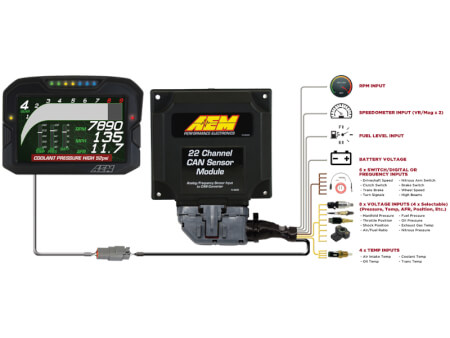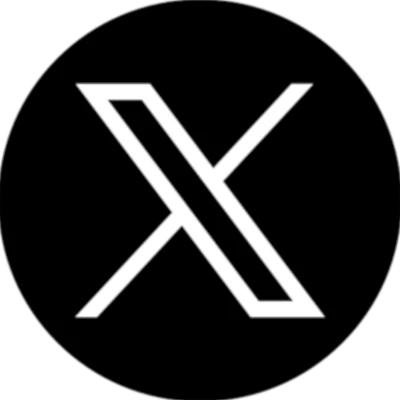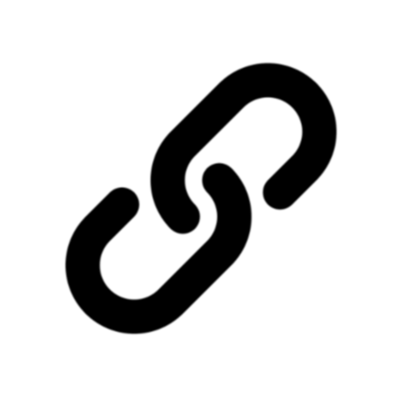
22 Channel CAN Sensor Module
AEM’s 22 Channel CAN Sensor Module (PN 30-2212) converts analog, digital and frequency inputs into an AEMnet CAN bus signal that can be transmitted to the CD-5 Carbon (releasing March, 2018) and CD-7 Digital Dashes. This expansion module provides a way for users with carbureted vehicles to add a CD Dash, and lets users with existing CAN-based devices add more channels to the display for viewing and/or data logging (data logging requires CD-5L Carbon or CD-7L logging Dashes). The 22-Channel CAN Sensor Module is compatible with the CD Dashes only; it will run in parallel with 3rd party CAN devices on the CD dashes but it is currently not compatible with AEM’s AQ-1 Data Logger, Series 2 or Infinity ECUs, or 3rd party ECUs or loggers.
FOR CARBURETED VEHICLES
The 22 Channel CAN Sensor Module has everything that users need to get data onto the Dash in a carbureted vehicle, including tachometer and fuel level, wheel speeds for MPH, and pressure/temp sensors. Users can daisy-chain two of the Modules together, which is ideal for enthusiasts who have a logging CD Dash and want to expand their logging capabilities.
FOR CAN-BASED EFI USERS
Racers who are using a CAN-based programmable ECU and have consumed all of the inputs in the ECUs now have a way to add more channels to a CD Dash without having to purchase multiple CAN-based devices.
WHAT YOU GET
The 22 Channel CAN Sensor Module includes four 0-5v analog inputs, four Temp inputs, four user configurable inputs for 0-5v, Temp or RTD, dedicated fuel level input, six digital inputs for switched or duty cycle, Tach input and two VR inputs for crank, wheel or driveshaft speeds. A harness is included with pre-pinned, 36-inch color-coded wires to connect inputs, and a DTM-style AEMnet cable to connect to a CD-5 Carbon or CD-7 Dash. Users can select the CAN speed delivery rate.
FEATURES
• Convert analog, digital and frequency-based inputs to AEMnet CAN bus for display on CD-5 Carbon and CD-7 Dashes!
• Perfect for users with carbureted vehicles who want to add a CD Dash display
• Ideal for EFI users who want to add more channels to a CD Dash without purchasing multiple CAN-based devices
• Daisy chain two Modules together for additional channels
• IP65-rated enclosure is ‘dust tight’ and water resistant
• Wiring harness included with 36-inch flying leads and pre-wired CAN cable
• Four Dedicated 0-5V analog inputs
• Four Temperature (thermistor) inputs
• Four User configurable analog inputs, (jumper selectable; 0-5v, thermistor, or RTD)
• One dedicated fuel level input (0 to 250 ohm range)
• Six Digital Inputs, active low, protected to ~18v, frequency, duty cycle or simple switch
• One Tach Input, trigger when low, 12v internal Pull Up
• Two VR pair frequency inputs (crank, wheel or drive shaft speeds)
• Jumper selectable CAN bus speeds, 250k,500k,1M
• Jumper selectable terminating resistor
• Jumper selectable header length, 11bit or 29 bit
• Dimensions: 4.7” L x 4.3” W x 1.4” H (not including connector)
• Weight: 6.4oz / 181.4g
ABOUT THE CD-5 CARBON and CD-7 DIGITAL DASHES
The CD-5 Carbon’s and CD-7’s main harnesses include two independent CAN bus inputs, so virtually any device with a CAN output can be added to your digital display. They are designed to accept channels from CAN bus connections, as well as two switched inputs and a headlight-in connection for automatic dimming. The CD digital Dashes are validated to support hundreds of 3rd party devices, in addition to AEMnet CAN-enabled products like our 22 Channel CAN Sensor Module (PN 30-2212) and/or our Vehicle Dynamics Module (PN 30-2206).
CD-5 Carbon and CD-7 color digital displays feature super bright, high contrast, sunlight readable five-inch and seven-inch screens that have an integrated glare diffuser and shade hood for readability in the brightest daylight conditions. Seven ultra-bright LEDs span the top of the display housing for RPM and shift light indication. Users can program them to ascend in specific increments based on RPM range, and flash when it is time to shift. Brightness is user programmable on the fixed color LEDs. Two large buttons are included on the face of the display, providing easy page changing and memory resetting, even with driving gloves on. Two additional programmable LEDs are located above the toggle buttons on the sides of the housings.





